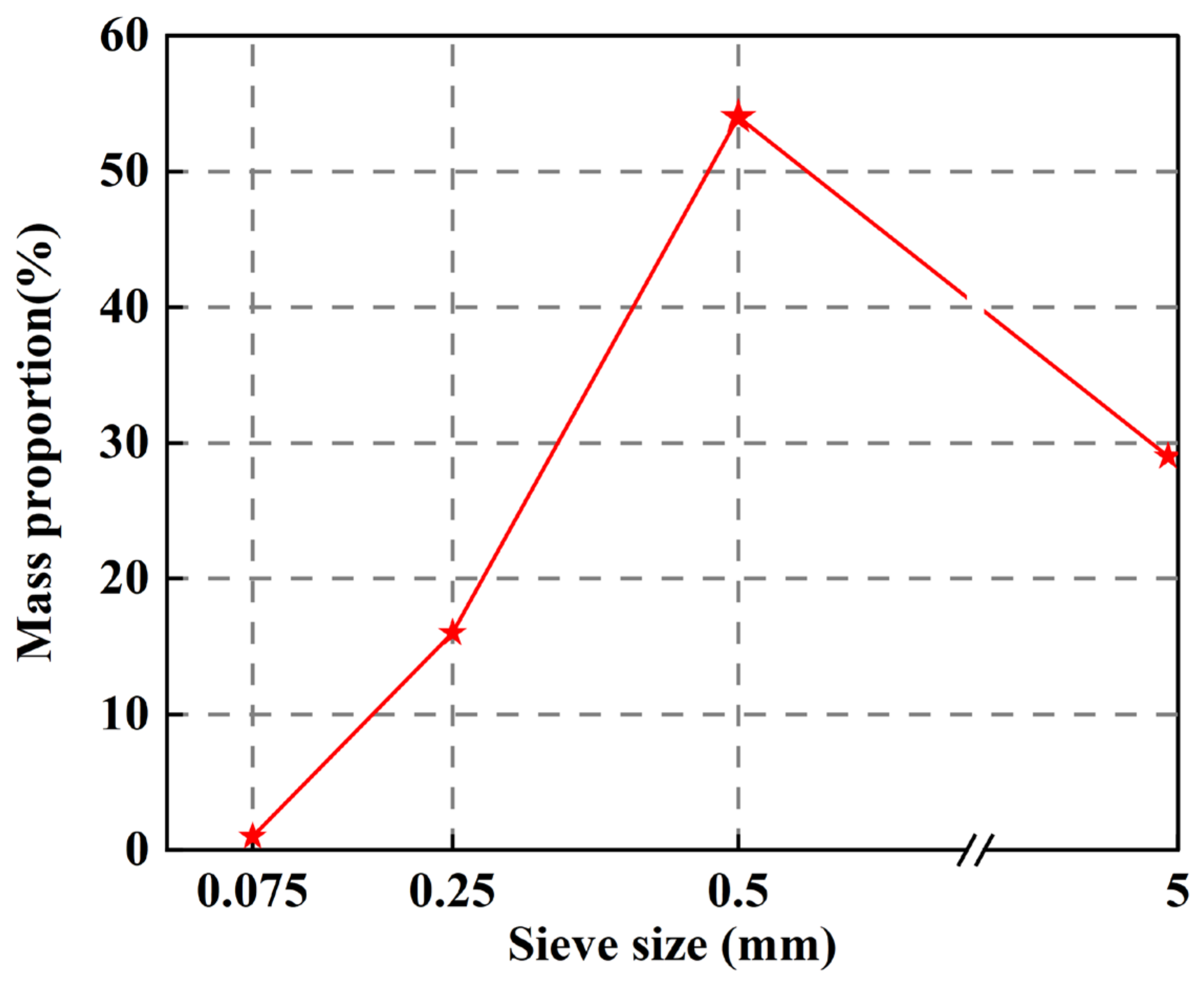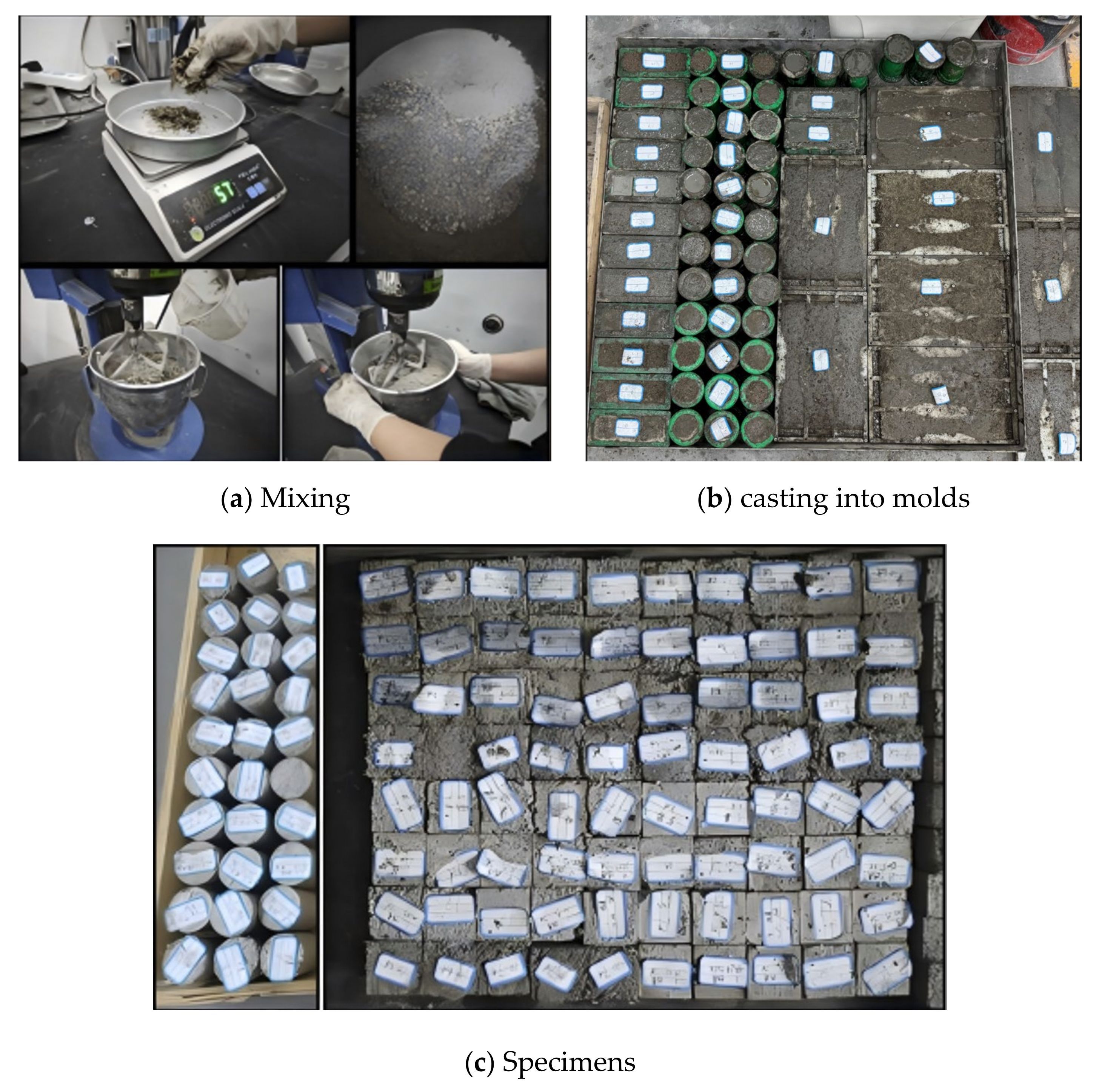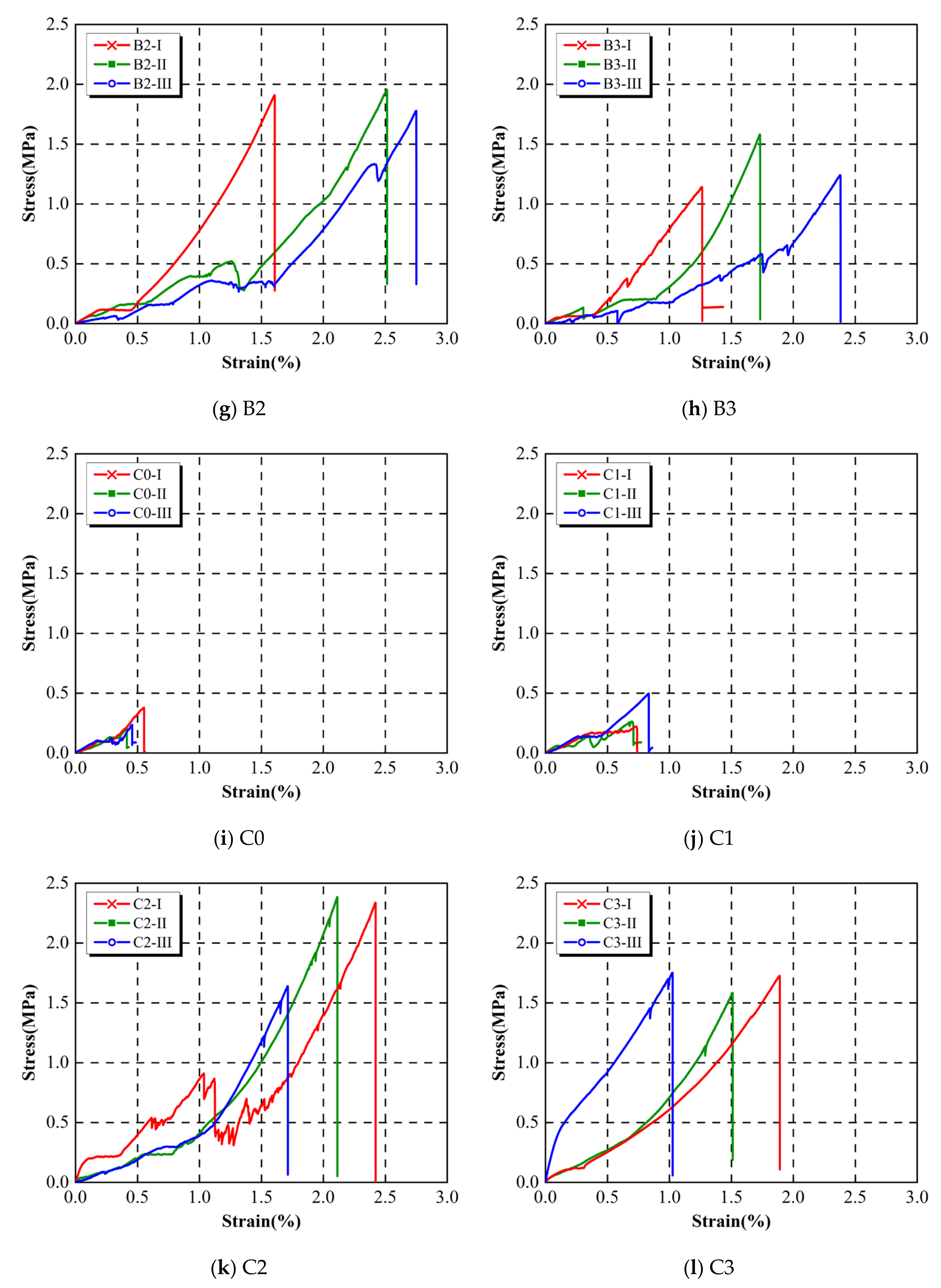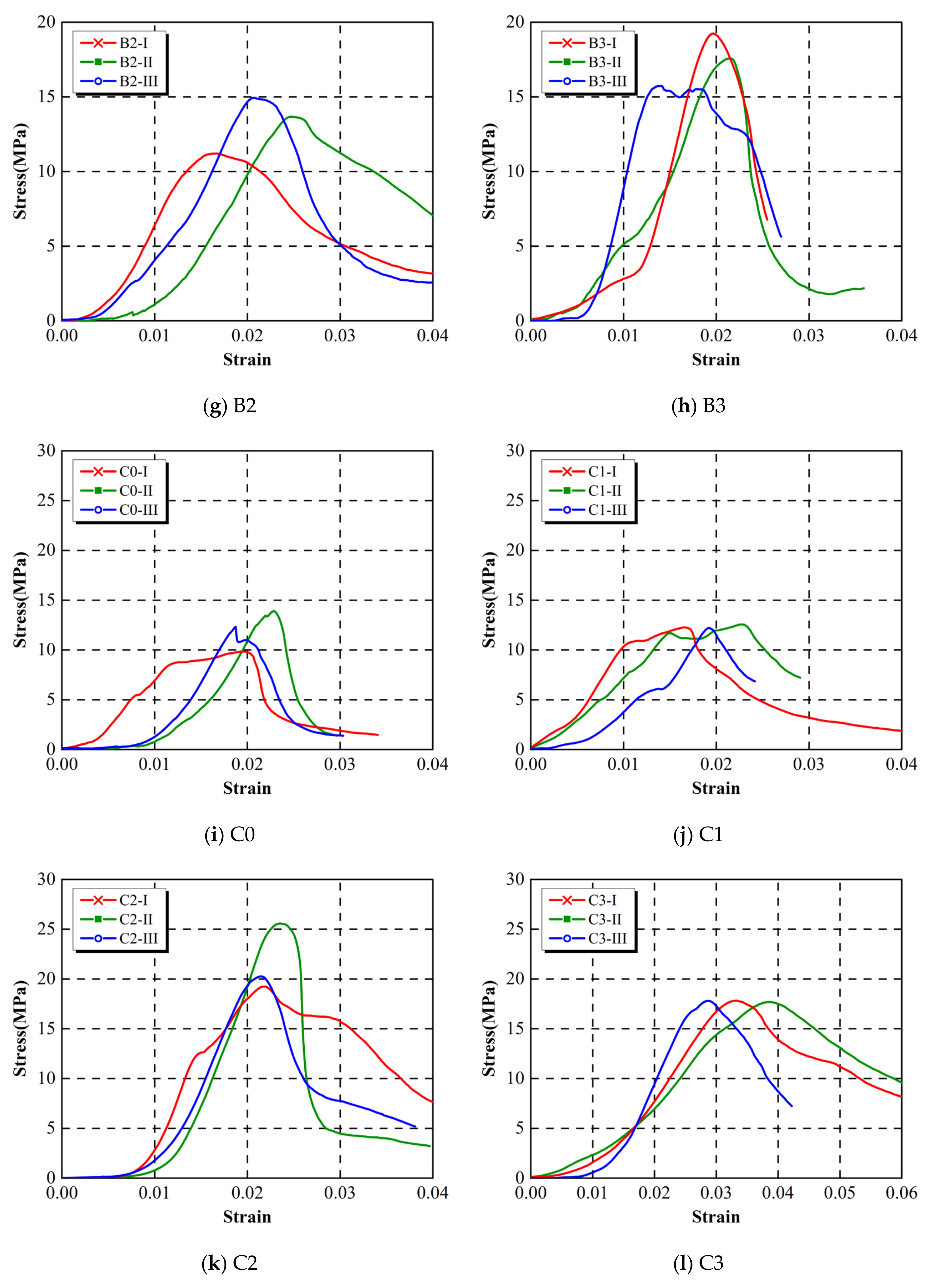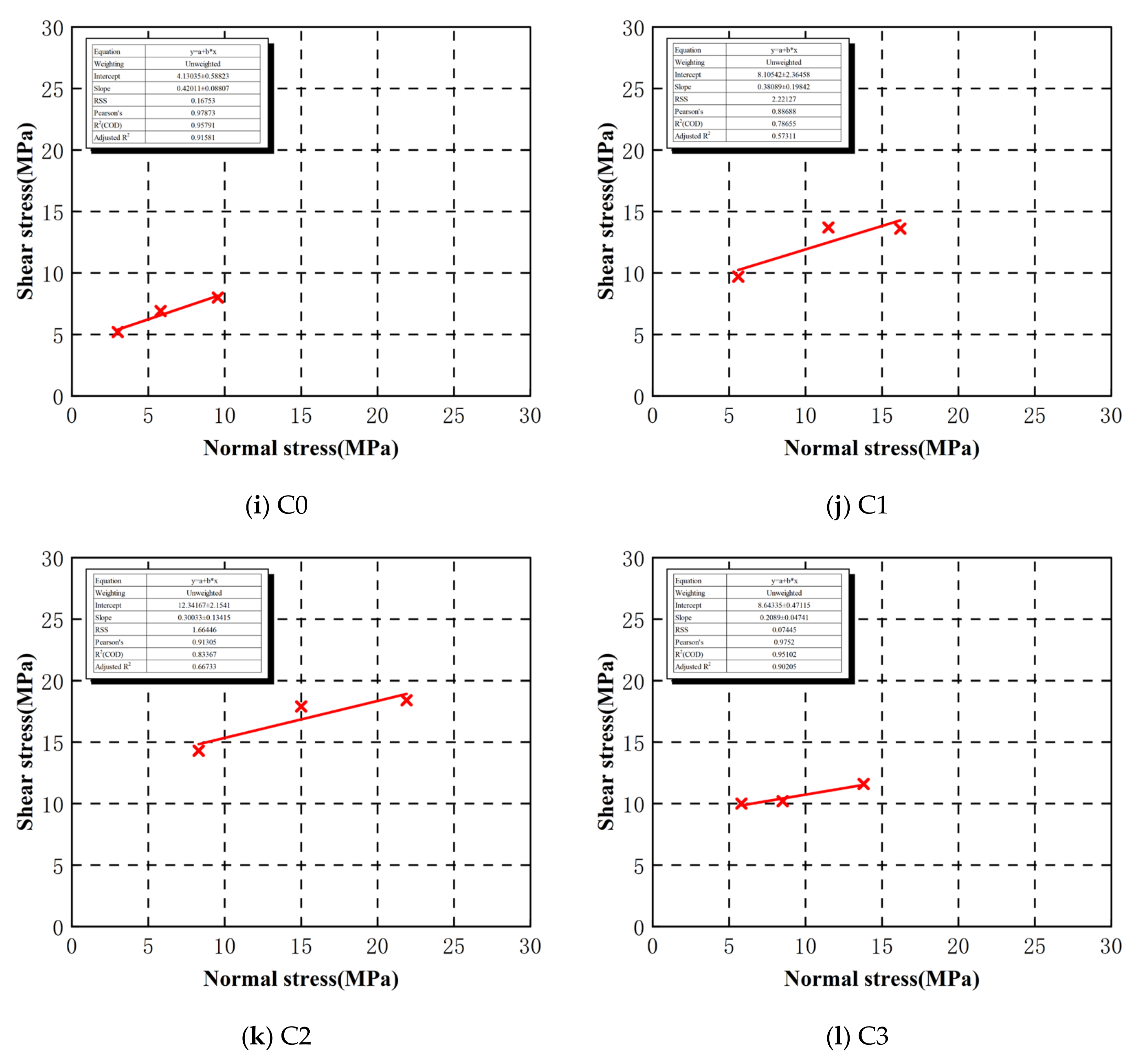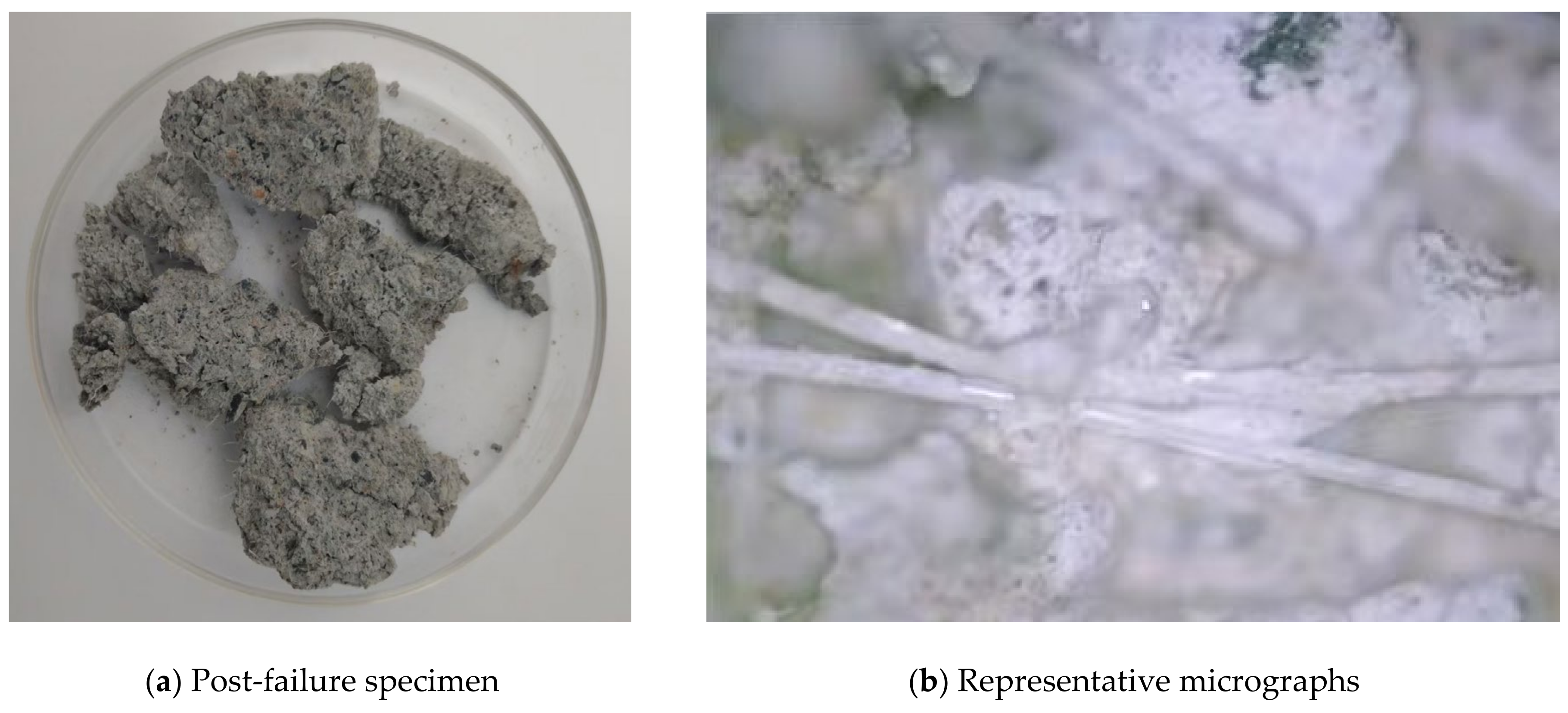1. Introduction
The safety and productivity of underground mines rely heavily on effective roadway support [
1]. In modern mining engineering, a combined rockbolt-shotcrete support system remains a cornerstone for stabilizing excavations, where rockbolts tie fractured rock to stable strata and shotcrete forms a continuous lining to prevent surface spalling and deformation [
2]. However, the trend toward larger roadway spans to boost haulage efficiency has inadvertently led to higher stress concentrations in the surrounding rock, pushing conventional shotcrete to its limits [
3,
4]. These conditions demand advanced cement-based materials with superior strength, toughness, and deformation capacity to ensure support reliability and safety in deep mines [
5].
To meet this challenge, extensive research has focused on enhancing the mechanical performance of concrete through material innovations. Strategies such as optimizing mix composition, incorporating mineral admixtures, and controlling hydration have shown benefits [
6], but fiber reinforcement has emerged as particularly effective due to its dual role in improving both load-bearing capacity and energy absorption [
4]. When dispersed within a brittle cement matrix, fibers act as tiny reinforcing bars that bridge cracks and restrain their propagation, thereby imparting pseudo-ductility to the composite [
7,
8]. This crack-bridging mechanism significantly raises the fracture toughness and post-cracking resilience of concrete, converting a normally brittle material into a tougher, more damage-tolerant composite [
9]. Even relatively flexible synthetic fibers have been shown to markedly improve ductility and control shrinkage cracking, thereby enhancing concrete performance under service conditions [
10,
11].
A wide variety of fibers have been investigated in fiber-reinforced concrete (FRC) and shotcrete (FRS), each offering distinct reinforcing mechanisms. Extensive studies have explored hybrid systems incorporating glass [
12], polypropylene (PP) [
10,
13,
14], basalt (BF) [
15,
16], carbon [
17], steel [
18], and plant-derived fibers [
19]. Synthetic fibers (typically polypropylene, PP, or other polyolefins) have gained popularity as a corrosion-free, lightweight alternative [
10]. Though having lower stiffness (~5–10 GPa) than steel, synthetic fibers can still significantly increase the toughness and deformability of concrete, especially under dynamic loads [
10,
20], and are effective at reducing early-age cracking due to shrinkage [
11]. Monteiro et al. reported that PP fibers at about ~0.3–0.7% volume improved the flexural response of self-consolidating concrete and that a hybrid combination of steel + PP fibers produced synergistic improvements in post-crack performance [
21]. In underground applications, synthetic fiber-reinforced shotcrete has been successfully used as initial linings [
22]. Beyond steel and PP fibers, other fiber types are actively researched for concrete and shotcrete reinforcement. Basalt fibers—drawn from volcanic rock—offer high tensile strength and a moderately high elastic modulus (~90–100 GPa) while being chemically inert and non-corroding. Dosages on the order of 0.3–1.0% by volume have been shown to enhance tensile and flexural behavior and improve toughness [
23,
24,
25]. For instance, several studies indicate that ~0.3–0.5% basalt fiber can maximize splitting-tensile strength and increase ultimate strain relative to plain concrete, while excessive content may impair workability [
24,
25]. Basalt fiber shotcrete has also shown promise in deep mining. Jiao et al. identified an optimal basalt fiber dosage around 4.5 kg/m
3 in wet-mix shotcrete panels, achieving a toughness ratio near the JSCE criterion and improving convergence control, whereas excessive fiber increased porosity and handling issues [
26]. Polyvinyl alcohol (PVA) fibers—owing to their hydrophilicity and strong interfacial bond—underpin engineered cementitious composites (ECC), which exhibit multiple micro-cracking and tensile strains exceeding 2% [
27]. In shotcrete practice, PVA micro-/short fibers have been reported to enhance adhesion and overall mechanical performance in high-performance shotcrete mixes, with ancillary benefits for rebound control noted in the shotcrete literature when microfibers are properly dosed [
27].
Over the past decades, both laboratory research and field trials have progressively advanced the understanding and application of fiber-reinforced shotcrete. Internationally, guidelines and testing standards (e.g., EFNARC specifications, ASTM C1550 panel test) have been developed to characterize FRS toughness, reflecting its acceptance as a mainstream support material [
28,
29]. Notable studies have quantified the performance gains from fibers: Cengiz and Turanli (2004) found that steel-fiber shotcrete panels achieved substantially higher peak load and ductility indices than mesh-reinforced panels in flexural tests [
30]. Recent experiments by Zhao et al. (2021) examined fiber–matrix interactions in FRS, showing that fiber failure mode (pull-out vs. rupture) correlates with composite strength, indicating how fiber properties influence overall performance [
31]. In China, basalt-fiber shotcrete research and field-scale evaluations have demonstrated improved toughness and convergence control with optimized dosages [
26]. Hybrid fiber systems are also gaining attention; by combining fibers of different types or scales, one can tailor multi-scale crack resistance. Asrani et al. showed that a hybrid of steel, PP, and glass fibers in geopolymer concrete markedly increased first-crack and failure impact resistance relative to plain matrices [
20]. There is also growing interest in innovative and eco-friendly fibers—for instance, using recycled steel fibers from waste tires as a low-cost replacement for industrial fibers, or employing machine-learning models to predict and optimize fiber concrete performance for given mix parameters. These efforts indicate a vibrant research landscape aimed at improving FRS performance, economy, and sustainability.
Despite the considerable progress, several knowledge gaps and practical challenges remain in fiber-reinforced shotcrete technology. Achieving uniform fiber dispersion in sprayed concrete is non-trivial. Poor dispersion or fiber clumping can negate the benefits, necessitating improved mix design and placement techniques [
28,
32]. The long-term durability of fibers in the aggressive underground environment is another concern—steel fibers risk corrosion and embrittlement over time, and some plant-based natural fibers may degrade in alkaline pore solutions [
33,
34]. The optimal fiber content is often a trade-off; while higher dosages generally enhance toughness, workability can deteriorate and even compressive strength may decline once fiber volume exceeds an optimum as the mix becomes fiber-saturated [
35]. Furthermore, most research to date has relied on standard laboratory tests that do not fully replicate the complex multi-axial stresses and scale effects in situ, underscoring the need for evaluations using field-produced shotcrete and more representative loading protocols [
36]. Finally, translating laboratory findings into practice requires robust, performance-based design methods and acceptance criteria tailored to mining conditions, where international guidance continues to evolve [
28].
Building on the above insights, the present study aims to develop a high-performance fiber-reinforced shotcrete material tailored for deep underground mine roadways. The research systematically investigates the effects of binder composition and fiber reinforcement on mechanical behavior, using practical engineering parameters from the Hatu Gold Mine. An orthogonal experimental design was adopted, incorporating PVA, PP, and BF fibers at 1–3% dosages to evaluate uniaxial compressive strength, tensile resistance, and shear performance. Based on the experimental results, an optimized fiber-reinforced mix was identified to meet the demanding requirements of deep-mine roadway support. In summary, this study addresses the aforementioned knowledge gap by providing laboratory-based evidence and guidance for improving shotcrete support performance in underground mining.
6. Discussion
6.1. Statistical Analysis
To quantitatively assess the effects of fibers on strength, an analysis of variance (ANOVA) was conducted on the 28-day compressive and tensile strength data. The orthogonal experimental design (three binder formulations, three fiber types, three fiber dosages) allows a factorial analysis of these variables. For compressive strength, the ANOVA confirmed that fiber content had the most pronounced influence, exceeding the effects of binder formulation and fiber type. In statistical terms, fiber dosage accounted for the largest portion of variance (range R = 4.65 MPa in range analysis), and its impact approached significance at the 90% confidence level (F-ratio ≈ 7.7). In contrast, the contributions of binder composition and fiber material were smaller (F ≈ 5.1 and 4.5, respectively, with p values on the order of 0.1–0.2). These results align with the range analysis hierarchy, which identified fiber dosage as the dominant factor governing compressive strength. Post hoc comparisons indicated that the 1% fiber dosage led to significantly higher compressive strength than 2% or 3% (mean 19.33 MPa vs. 14.68 and 15.68 MPa). This finding statistically corroborates the earlier observation that excessive fiber content (≥2%) is detrimental due to fiber agglomeration and porosity, whereas a low dosage (1%) optimizes the fiber–matrix synergy.
For tensile strength, the ANOVA results highlighted fiber type as the most critical factor (F ≈ 6.25, accounting for ~78% of variance), consistent with polypropylene (PP) fibers imparting the greatest tensile capacity. Fiber content and binder formulation had comparatively minor effects on tensile strength (both F < 1), indicating that the choice of fiber material governs tensile performance more strongly than mixture proportion variables. These trends mirror the range analysis: fiber type ranked as the top influence on tensile strength, followed by fiber dosage, then binder. Statistically, the superiority of PP fibers over others is highly pronounced. In our results, PP fiber composites achieved higher mean tensile strength (K ≈ 1.86 MPa) than basalt (1.66 MPa) or PVA (0.63 MPa) fiber composites. In fact, the best-performing mix (Binder C with 1% PP) reached 2.17 MPa direct tensile strength, which is ~675% higher than the corresponding plain matrix (Binder C without fibers: 0.28 MPa). Even considering different binder systems, PP fibers provided roughly 12% greater tensile strength than basalt fibers and 195% greater than PVA fibers in the orthogonal set. This reflects the high ductility and crack-bridging efficiency of PP fibers, as discussed earlier. Meanwhile, the statistical effect of fiber dosage on tensile metrics was modest; a 1% fiber volume showed the optimal tensile strength (mean K ≈ 1.48 MPa) compared to 2% and 3%, but the differences were not as large as in compression. Overall, the ANOVA-supported analysis reinforces that (i) increasing fiber content from 0 to 1% yields significant strength gains, beyond which further increases can be counterproductive, and (ii) fiber material selection (especially using PP or stiff basalt fibers) is pivotal for maximizing tensile improvements. These statistical findings lend confidence that the reported strength enhancements due to fibers are real and not merely due to experimental scatter.
6.2. Engineering Implications
Under optical microscopy (see
Figure 7), most fibers in the hardened composites were observed to be pulled out from the cement matrix rather than fractured. This pull-out failure mode (as opposed to fiber rupture) suggests that the fiber–matrix interface was the critical weak link governing post-crack behavior. Because the fibers used were relatively large in diameter, optical microscopy rather than scanning electron microscopy was required for detailed observation. Nonetheless, the macroscopic evidence of fibers bridging cracks and then debonding is clear. The prevalence of fiber pull-out implies that the fibers’ tensile capacity was not fully utilized at peak load—the interfacial bond or friction was overcome before the fibers themselves broke. In design terms, this outcome is not unfavorable: a controlled pull-out process dissipates significant energy and thus enhances toughness. It also indicates potential for further improvement: strengthening the fiber–cement bond (through fiber surface treatments or mineral additives) could increase the load carried by each fiber, albeit with the trade-off that excessively strong bonding might cause fibers to rupture and reduce the overall energy absorption capacity.
The fiber–cement interface plays a pivotal role in composite performance and durability. Different fibers engage with the matrix in distinct ways. PVA fibers are hydrophilic and tend to form strong chemical bonds with cement hydration products, likely contributing to the composite’s tensile gains (though excessive fiber agglomeration can introduce voids) [
27]. PP fibers, being hydrophobic and relatively smooth, rely mainly on friction and mechanical interlock. Their bond to the cement matrix is weak which is why PP fibers were more readily pulled out [
43]. Basalt fibers, as a mineral silicate, have surface characteristics that promote both chemical adhesion and mechanical interlocking with the cement paste [
44]. In this study, however, all fiber types predominantly underwent pull-out, indicating that interfacial bonding was moderate. Importantly, fiber pull-out can be beneficial for durability. When cracks form, intact fibers continue to bridge the cracks, limiting crack width and slowing crack propagation. By contrast, if fibers were to fracture, they would immediately lose effectiveness at the crack plane. The ongoing bridging action of pulled fibers helps maintain the integrity of the composite under load and environmental stress.
Consistent with these mechanisms, fiber-reinforced mixes generally exhibit superior durability compared to plain concrete. Numerous studies have shown that fiber reinforcement mitigates common deterioration mechanisms by restricting crack growth. For instance, when only 0.1% basalt fiber was added to concrete and subjected to 75 freeze–thaw cycles, the mass loss was 26% lower and the relative dynamic modulus was ~14.8% higher than those of plain concrete [
45]. Fibers impede the ingress of water and delay internal damage, thereby improving freeze–thaw resistance. Similarly, PVA fibers have been found to preserve tensile performance during freeze–thaw cycling, although their inclusion may slightly reduce permeability and carbonation resistance in shotcrete depending on dosage and mix design [
46]. Basalt fiber shotcrete is reported to dramatically improve toughness and durability in harsh environments (tunnels, mines) [
47]. Polypropylene fiber is well known for enhancing concrete’s resistance to explosive spalling (e.g., in fire scenarios) and for imparting ductility under dynamic loads [
48]. Taken together, these insights suggest that the fiber-reinforced composite developed here would likely show improved durability (better fatigue life, freeze–thaw performance, crack control, etc.) in mining conditions, though dedicated long-term tests should be conducted in future work to confirm this.
From an engineering application standpoint, implementing these fiber-reinforced materials in practical mining operations requires careful consideration of cost, workability, and safety. Among the fibers studied, polypropylene is the most economically attractive and is already widely used in shotcrete for mining due to its low cost and effectiveness in controlling shrinkage cracks. Basalt fiber, while more expensive than PP, offers a compelling combination of high strength, corrosion resistance, and thermal stability, and it is non-conductive and non-corroding, making it a promising replacement for steel fibers in underground settings [
49]. PVA fiber is relatively costly and was used here primarily for its exceptional bond and tensile performance; its large-scale use in industry may be limited by price, but it could be justified in specialized applications where superior tensile capacity or crack control is critical (for example, in thin sprayed liners requiring high ductility).
In terms of workability, the inclusion of fibers can pose challenges. All fiber types tend to reduce the workability of fresh concrete by causing mix entanglement and absorbing free water, which can hinder pumping or spraying operations. Additional measures are often needed to maintain workability—such as using superplasticizers, optimizing fiber lengths, or limiting fiber dosage [
50]. Indeed, it is generally recommended that fiber volume fractions not exceed about 1% in wet-mix shotcrete to avoid clogging and rebound issues. In this study, with fiber contents approaching ~2% by volume, we addressed workability by employing a high-range water reducer and extended mixing time to ensure uniform fiber dispersion. Scale-up and long-term production considerations must also be addressed. Ensuring consistent fiber distribution in large batches of concrete and preventing fiber segregation will require quality control measures (e.g., pre-dispersion of fibers or specialized mixing protocols) when moving from lab scale to field applications. There are also economic implications over the service life of a project: while fibers increase the initial material cost, they may reduce life-cycle costs by improving the durability and reducing maintenance of support structures. For example, better crack control and toughness could decrease the frequency of repairs in tunnels and drifts. To convince stakeholders of these benefits, a clear cost–benefit analysis or pilot implementation may be necessary, demonstrating that the long-term savings and performance gains outweigh the upfront expenses.
Safety and risk factors are also crucial in mine applications. Introducing a new material for ground support in underground workings necessitates thorough validation of its reliability under field conditions—sudden or unpredictable failure is unacceptable in such environments. The fiber-reinforced composite developed in this study has shown enhanced tensile resilience and toughness, which is promising from a safety perspective, but its long-term behavior under sustained loads, creep, and the specific environmental conditions of mines (humidity, temperature fluctuations, chemical exposure) remains to be investigated. It is acknowledged that the present study did not examine these long-term aspects; thus, further in situ trials and monitoring would be prudent before full deployment in mines. Nonetheless, the findings at hand provide a strong foundation: the improved mechanical performance and expected durability of the fiber-reinforced material suggest it can enhance the stability and longevity of underground structures. By candidly pointing out the current limitations of this research (e.g., lack of prolonged durability tests, unresolved cost factors) while emphasizing the demonstrated benefits, a balanced perspective is presented. This approach ensures that the conclusions—namely, that fiber reinforcement significantly boosts tensile performance without compromising compressive strength, and that it holds promise for real-world mining applications—are viewed in the appropriate context of both potential and caution.
